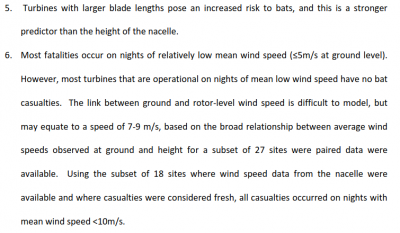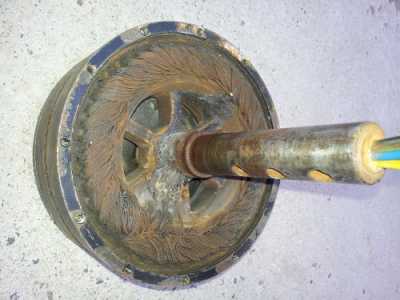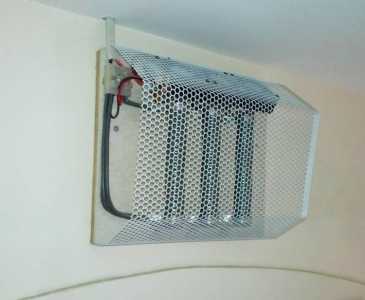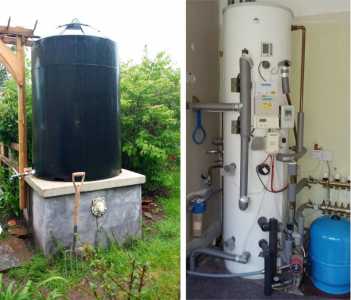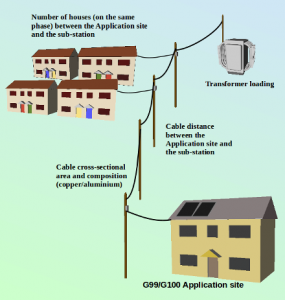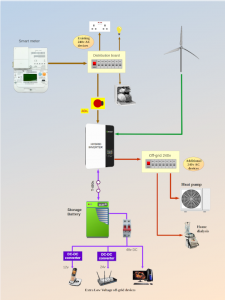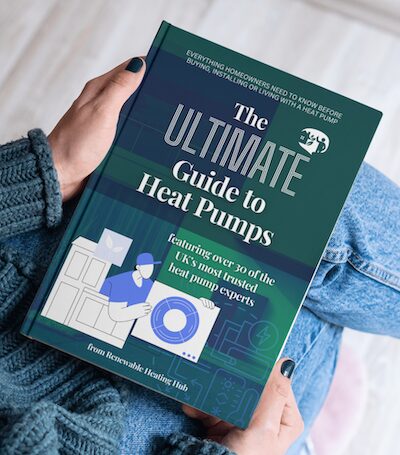Wind turbines, planning applications and implementation
We've recently had our pre-planning application back from our local council for us to install an SD6 wind turbine from SD Wind in Scotland.
Our pre-planning application was submitted in May 2022 and we got a response in early November. It takes time! We are in the countryside, but our council is Stockport in Greater Manchester.
Overall, the response was positive. We already have a pylon in the field, so that spoils the view anyway.
However, issues that were raised were noise (shouldn't be an issue as it will be at least 150m from our property and at least 750m from the next property) and bats. We shouldn't need to get a bat survey done, but will need to acknowledge in our full planning application that we will put in place measures such as a couple of bat boxes nearer to our home.
The reason we want a turbine is to power our house, office outbuilding, two ASHPs and provide energy for our EV. As we live in a very windy location, it seems to make more sense to use wind rather than solar as it is also windier when we need more heating.
Our planning consultant is just preparing the full application now.
I'll share updates when we have them, but any others who have experiences of turbines and the planning process, would be good to see.
I designed & built my own wind-turbine about 10 years ago.
It worked well for 3-years until the night of the storm when it caught fire. 
I've learned quite a lot about planning consent over the years. I can assure you that one objection does not mean refusal. There have to be valid planning reasons for an application being rejected. But I strongly suggest you contact the local Borough/District Councillor(s) for your ward, and give them background information of what you're up to.
They have the ability to 'call in' your application for discussion by the full Planning Committee if the senior planning officer recommends refusal. So you then have 3 minutes to tell them about the energy crisis and why local micro-generation should be encouraged. Anyone (including me) can write in support of your application. I do not need to live in your area.
As mine was a DIY construction I was unable to provide manufacturer's figures for noise. That isn't a problem if the neighbours are sufficiently far away or are shielded by buildings or trees.
There are rules on 'shadow-flicker' and epilepsy, which we can discuss here if you or your Councillors want.
Our turbine was also one of those selected for inclusion in a nationwide survey on the potential environmental harm to bats. We have 15 of the 18 species of British bats within a mile of this site, so such research work was essential. We were visited once a month by a 'bat dog' and his handler, looking for pieces of bat corpse. None were found.
Save energy... recycle electrons!
The bat survey in which my wind-turbine site was included, was undertaken by Exeter University during 2013-14, and the report published online by DEFRA.
In a nutshell, the faster the blades turn, the easier it is for bats to detect them by echo-location. They appear more 'solid' and can be avoided.
Here's a snippet from page-12 of the report:
Due to the tip/wind-speed ratio, smaller (domestic) turbines rotate faster. Larger commercial turbines use gearing to ensure that the blade-tip is moving at a lower velocity than the wind, and are therefore harder for bats to detect.
Save energy... recycle electrons!
Regulation of noise from wind-turbines was created in 1997. It is discussed widely online, and can be found by searching for ETSU-R-97
There are very many objections to the ETSU guidance, from complainants on both sides of the argument. Eg some people noted that the committee only assessed noise within the audible spectrum of homo sapiens!
Remember that most noise emanating from smaller, domestic wind turbines will originate from
- the shaft bearings
- any taught stays which may be used to hold the tower aloft
Bearings are unlikely to cause a noise hazard within the ETSU guidance if they are re-greased during an annual maintenance regime.
Few installations now use steel stay-wires. Tubular towers are preferred.
Save energy... recycle electrons!
Unlike PV solar panels, wind-turbines shouldn't be turned off by an electrical switch. That would prevent the generator head from exporting its energy. The blades would turn very fast and the windings will overheat.
I know this from personal experience when my PMG (Permanent Magnet Generator) had a bearing failure. I awoke to see it spinning merrily, but producing no output current. Here's the result after the fire which had melted the enamel on the armature wires:
The controller system is very important and must 'fail safe' by presenting an electrical load adequate to take all the output power.
Ideally you should have a storage battery as your primary load.
I have a '24v' immersion heater in my 300-litre thermal store, and three homemade 'air heaters' within the house. Those give me two levels of backup dump-loads in the event of the storage battery being full.
Save energy... recycle electrons!
@transparent Thank you for all this - I'll send it to my planning consultant. It is really helpful.
@transparent SD Wind have recommended a specialist installer. I imagine we'd try and put any excess into our EV or hot water, but if we need an extra battery, then we'll do that too.
The SD Wind 6kW unit is well known to me from the days when it was developed by Proven. Unlike many other small turbines it doesn't use a furling mechanism to turn itself out of the wind when it gets too strong. It changes the pitch of the blades and just keeps generating.
For this reason you absolutely must take care to have a load which is adequate for peak conditions. Averages should play no part in your calculations, any more than you can build a maternity hospital for the average number of deliveries in the year! Nature doesn't work like that.
There are different versions of the 6kW turbine, offering three different voltage output ranges. Personally I'd be leaning towards the one at a nominal 48v, and then use lithium (LiFePO4) battery storage.
You can't rely on charging the EV because it may not be there when required, or its battery might already be full.
Nor can you rely on the mains grid to take the output. The usual export level approved by your Distribution Network Operator (DNO) is 16A per phase. That's just 3.68kW for the standard G98-certified connection.
Moreover you need to consider what happens during a grid-outage. Any G-98 equipment incorporates anti-islanding. That means it will not operate in the absence of the 50Hz mains frequency, and takes itself off-line.
Think too about your neighbours who will want to emulate your micro-generation strategy. Those closest to you will most certainly be connected to the same feed from the same sub-station transformer. If you negotiate with your DNO to have more than 3.68kW of export, then they are even less likely to be offered a grid-connection!
Heating water is an option for a dump-load. But do a quick bit of maths.
To raise the temperature of mains-fed water from 10degC to 100degC requires about 0.1kWh of electricity per litre.
If you have a whole day of storms, a 6kW turbine could bring 1440-litres of water to the boil. That's about 5x the capacity of the thermal-store in my 6-bed house. In fact it's roughly the same amount of water in my largest 'water butt'.
You'll need to build a hot-tub jacuzzi for all your partner's horses!
Save energy... recycle electrons!
That's really interesting and useful. Do you have any recommendations on battery storage size? Clearly, it is an additional cost but sounds like it is worth doing especially as the export tariffs are so low. Would it make sense to get one with an inverter built into it?
One of the attractions of the SD6 was that it continued generating in storms, as it can get really wild up here. But with our hot water tank being 300 litres, you are correct that we would be generating much more than we can use.
I have lots of recommendations on storage batteries @knukes
I have two independent battery storage trials operating in the plant-room just behind where I'm sitting. 🙂
Forget the inverter for the moment. I'm also temporarily ignoring the control box which I expect the wind turbine comes with.
Step one: don't wait for your installer to take action, but make your own application to your DNO for grid export. I think you're with Electricity North West. Go to their guidance page on G98/G99 connections and submit an Application Form G98B jor just the 6kW wind turbine (no storage).
In theory this gets refused because you would export more than 16A/phase if no-one was using any at home. But let's see what they say. The service costs nothing and it gets the ball rolling.
Send an accompanying email asking for them to send a map showing the local Distribution Grid for the area. (I'm afraid I only have access to four of the 14 DNO Regional maps, and yours isn't one of those).
That map should arrive by email and show you the location of your house, the local substation to which you're connected, and other useful data. We're interested in things like:
- the cable distance between you and the transformer
- the size and construction of that cable (copper or aluminium conductor)
- how many other properties are on the same feed
- how many houses between you and the sub-station
Don't worry about how this data gets used yet. Suffice to say that it forms part of the input to the formula used to calculate approval for G99/G100 connections.
Step two: Start thinking about the two main categories of storage battery:
Grid-connected. Imports and exports at 240v AC. So its potential export gets added to that of the wind-turbine when calculating the G99 application. If the mains grid goes down, then your storage battery shuts down.
Off-grid. Can import from the grid or your wind-turbine. It cannot export back to the grid. You do not require DNO approval. Its inverter supplies in-house devices which require 240v AC, such as your heat pump.
Step three: Read the topic A beginners Guide to Home Energy Storage which new-member @korwraith has just started today.
He's about 4 months ahead of where you are, and provides his working calculations, which is very helpful.
Step four: Tell your neighbours and local Councillors that this discussion exists. They can join in, or merely watch/read.
We're heading in the direction of a solution to the energy-crisis, which will be of interest to your Local Planning Authority (LPA) and Housing Associations.
Although you're only considering this for your own heritage property, it could equally well be applied to new-build clusters of affordable homes. The cluster would have shared ownership of an Energy Hub, which can supply heating and off-grid power to each house.
Save energy... recycle electrons!
@transparent Thank you.
Just to clarify, if I go for off-grid battery storage, does that mean I don't need to do the G99 application?
- 26 Forums
- 2,356 Topics
- 53.4 K Posts
- 278 Online
- 6,017 Members
Join Us!
Worth Watching
Latest Posts
-
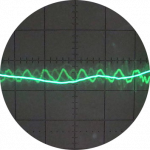
RE: Setback savings - fact or fiction?
I could, but I think we can do better, by plotting hour...
By cathodeRay , 2 hours ago
-
RE: Midea ASHP – how to set weather compensation
Just one more thought. If you have convenient space fo...
By JamesPa , 3 hours ago
-
RE: Advice on internal circulation pump noise
Extend the primary branch and make sure you have more t...
By ASHP-BOBBA , 4 hours ago
-

RE: External pipework insulation
Oh Dear! that's appalling pipe work, should've been in ...
By dgclimatecontrol , 9 hours ago
-

RE: Jokes and fun posts about heat pumps and renewables
By Morgan , 10 hours ago
-

RE: Controlling Daikin Altherma via P1P2 and Home Assistant
On the contrary, @toodles, that’s a lot of help. I’d ne...
By Majordennisbloodnok , 12 hours ago
-
RE: Octopus Cosy Heat Pump Owners & Discussion Thread
@kevh with the Cosy 6 I know it definitely goes to arou...
By HarrisonC , 1 day ago
-

Parsnip, Bacon & Coconut Milk Soup
First let me say, I am only a cook because I am human a...
By Toodles , 1 day ago
-
RE: Electricity price predictions
Ben Watts posted on LinkedIn that he had updated this w...
By Judith , 1 day ago
-

RE: The good, the bad and the not that great – my heat pump installation
Small update, Emailed and Spoke to Midea UK and they ...
By Burtis , 1 day ago
-
RE: Solis S6-EH1P8K-L-PLUS – Why I Chose It and What I’ve Learned So Far
@bash Octopus does charge for the admin. The process al...
By Batpred , 1 day ago
-
RE: New Fogstar 15.5kWh upright solution
Issues still under investigation by Solis... Fogstar ...
By Batpred , 1 day ago
-
RE: Who's your electricity provider and what's your tariff?
I agree, the consumer is not being properly represented...
By Batpred , 1 day ago
-

RE: Heat Pump Heats the House… But It’s Not Cosy. Emitter Changes or System Tweak?
@toodles interesting suggestion, thanks. I will try to...
By GrahamF , 2 days ago
-
RE: Mitsubishi Ecodan Auto Adaption trial to stop cycling.
The interval you talk of, i think, will be 60min for an...
By F1p , 2 days ago
-
Agree with @majordennisbloodnok on the setbacks. We hav...
By ChandyKris , 3 days ago
-

RE: Speedcomfort radiator fans
@deltona the way the links were added broke the page. A...
By Mars , 3 days ago
-

RE: Refrigerant R32, is it now banned in the EU from 1st Jan 2027 for monobloc ASHPs?
This has been delayed from what I believe to be this ye...
By dgclimatecontrol , 3 days ago

